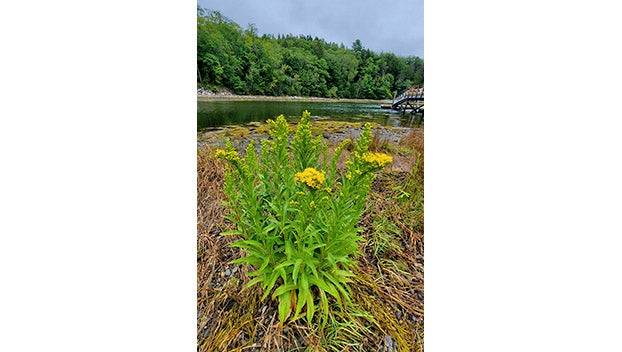Mother Natures Garden — Goldenrods: Tenacious and beautiful
Published 1:56 pm Saturday, November 12, 2022

- Seaside goldenrod (Solidago sempervirens) is an evergreen species that grows two to eight feet tall and is found in dune grasslands, sandy shores of tidal rivers, and in interdune swales. It’s common in the outer maritime zone of the Coastal Plain of Virginia, north Maine.
|
Getting your Trinity Audio player ready...
|
“You can see the goldenrod, that most tenacious and pernicious and beauteous of all New England flora, bowing away from the wind like a great and silent congregation.” — Stephen King
King’s description just about sums up most people’s feelings about goldenrod. It’s beautiful, but ubiquitous, and somehow overwhelming. Tough, but also slightly sinister because of its ability to grow just about anywhere – seaside dunes, marshes, mountains, even the tundra. And then there is the problem of identification. Who can tell all those species apart?
There are 90 to 120 species in the genus Solidago. They’re primarily found in North America, but there are a few in South America, Eurasia, and Micronesia. Here in Virginia, we have over 40 species, including those with flat-topped inflorescences whose placement in Solidago is controversial.
In general terms, goldenrods grow from rhizomes and have erect or decumbent stems that range in height from just a few inches to over six feet tall. Leaves and stems can be smooth or hairy. The flowerheads usually have both ray and disk florets and are grouped in racemes, panicles, or corymbs. With just a few exceptions, all the blooms are yellow. Here in Virginia, the exception is silverrod (Solidago bicolor), which is cream colored.
Goldenrod flowers produce both pollen and nectar and, contrary to popular belief, are not wind pollinated, but by insects. The pollen is too heavy and sticky to be carried very far by the wind. Unfortunately, goldenrod is much maligned as a cause of late summer/early fall hay fever. Even the Disney movie Snow White and the Seven Dwarfs promulgated this myth. As you may remember, the dwarf Bashful shoves a vase of goldenrod into Sneezy’s face, and he has a hay fever attack.
Goldenrod has a long history of varying uses. The Great Saladin, the caliph of Egypt who fought King Richard in the third crusade, believed that goldenrod was an important medicine for healing wounds, and he introduced its use throughout the Middle East. It was also used to produce a brilliant yellow dye. During the reign of Queen Elizabeth I in England, goldenrod leaves were pulverized and sold as an expensive treatment for wounds. During the American Revolution, the leaves of sweet goldenrod were dried and used to brew Liberty Tea. Beekeepers know that honeybees collect large amounts of goldenrod pollen and nectar in late fall when other sources of energy are disappearing. Goldenrod honey is dark, spicy, and somewhat bitter.
More recently, Thomas Edison experimented with goldenrod as a source of rubber. He was able to grow unusually tall plants that had a high concentration of rubber in their leaves. His friend Henry Ford gave him a Model T with tires made of rubber produced from goldenrods. Somewhat later in the early 1940s, Henry Ford and George Washington Carver collaborated on experiments to use goldenrods as an alternative commercial source of rubber.
Goldenrod. The plant that’s considered by many to be a weed, but is slowly seeping into the consciousness of gardeners. The plant that means autumn to photographers and nature lovers, but is reviled by others who are convinced that it provokes hay fever attacks.
Dr. Cynthia Wood is a master gardener who writes two columns for The Herald. Her email address is cynthia.crewe23930@gmail.com.





